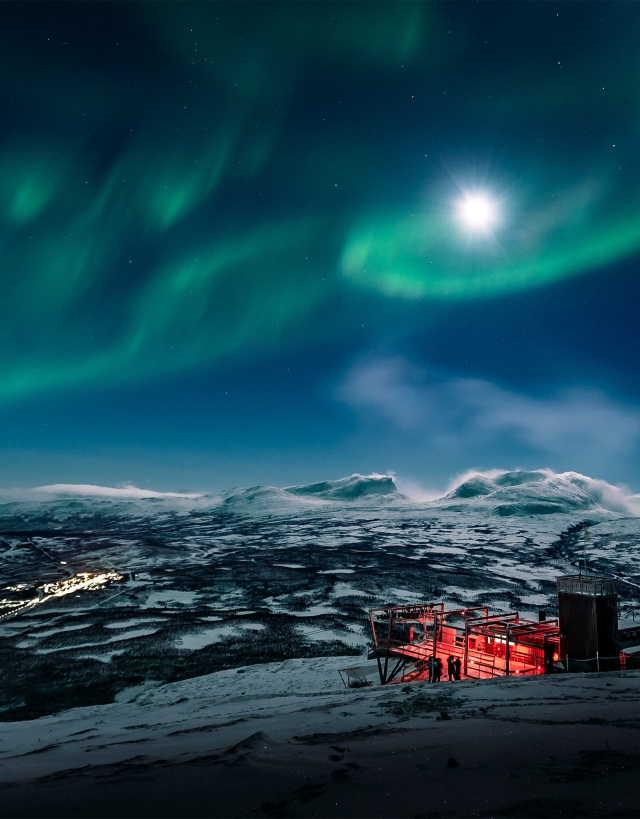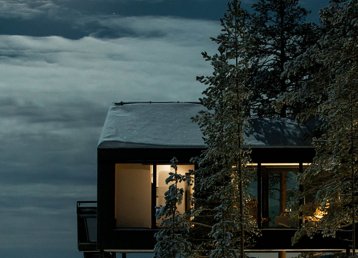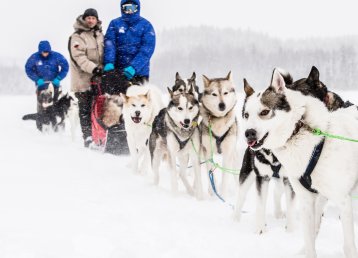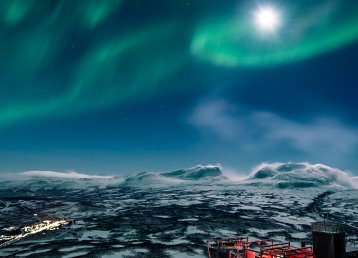On February 2, 1925, the Norwegian Gunnar Kaasen entered the town Nome as a hero with his dog sled team and his lead dog Balto. He delivers ten kilos of vaccine to a town affected by the deadly epidemic diphtheria. Kaasen’s arrival marks the end of a week-long story in the world press, about a six-day dog sled relay to “the end of the world”. Gunnar Kaasen and his dog Balto are the heroes of the event, those who are associated with the success. Balto even gets a statue in Central Park in New York, and Kaasen himself travels around on an exhibition tour for several years. But to other mushers and the general public, there were other, unsung, heroes: they were called Leonhard and Togo and came from the north. They made an extraordinary and heroic effort under terribly harsh weather conditions. Altogether, the two of them and their team of dogs, travelled for more than 400 kilometres through Alaska, through blizzards and cold, to save the people of their hometown.
Seppala and Swedish Lapland
Leonhard Seppala, born 1877, would during those days go from being a good musher and just another hard-working blue-collar man to being the most famous dog-team driver in the world. His dog Togo would earn his place in the history books and a place at the Yales Peabody Institute. Life with dogs was something Leonhard Seppala was born into, even if he didn’t know it himself until he got his first dogs. His dogs – not least his most famous dog, the lead dog Togo – soon realised that their master was made from different, sturdy stock. Togo gave his entire life to his musher. But we’ll get to that later. Leonhard Seppala’s father was called Isak Seppälä, and he came from Junosuando, on the Arctic Circle in Pajala municipality, in Swedish Lapland. The family later moved to Norway and Leonhard emigrated to Alaska to dig for gold, something he soon gave up and started working as a musher to transport the gold instead.
A stubborn dog
Togo was born in October 1913, lacking the physical attributes his musher believed were necessary to become a lead dog or even a good sled dog in the first place. As a puppy, he was sick and grew up to be almost impossibly stubborn and wilful. So Leonhard gave him away. The story about Togo escaping from his new owner by jumping straight through the glass pane of a closed window and then running back to his old home is a well-known one. Leonhard thought: “I guess he’d rather stay here”. So be it.
“I’d simply found a dog born to be a lead dog.”
But Togo didn’t make life simple for himself or his musher. Every time Leonhard took a team of dogs out, Togo escaped to join them. During these tours, he’d attack other lead dogs, in his mind to help his master. Once he attacked a large Alaskan malamute and was severely injured. After that, he never attacked another lead dog, and Leonhard didn’t have to worry about confrontations with other teams again. Eventually, on a trip where Togo had escaped to run next to the team and cause havoc, Leonhard had to harness him. Before that trip was over the little dog had advanced through the team and ended up next to the then lead dog, Russky. Togo ran for 120 kilometres on his first tour in a harness. Something that was unheard of among mushers at the time. Leonhard Seppala commented: “I’d simply found a dog born to be a lead dog”. In a dog he thought would amount to nothing, a dog he’d tried to give away, he found what he’d been trying to breed for decades.
A matter of life and death
In January 1925 the deadly disease diphtheria had broken out in the coastal town of Nome, by the Pacific Ocean. Leonhard Seppala lived there with his family, and his eight-year-old daughter Sigrid was now in mortal danger because the vaccine available in town had expired and probably wouldn’t be enough in any case. The frozen town could only be saved if the new serum arrived in time.
Already a month prior to the outbreak the provincial physician Curtis Welch in Nome had asked for a serum to be sent to the town. But collecting it took time, and the governing politicians probably delayed in deciding whether it was worth the money. The residents of Nome were mostly indigenous people. Reading Dr Welch’s telegram, it seems perhaps they weren’t the highest priority, as the doctor concludes his emergency message with “There are 300 whites living in the area”. The new vaccine was on its way on the train from Anchorage, but when the train was due to depart the worst cold in the memory of living individuals had struck Alaska. It was minus 50°C, and the aircraft meant to carry supplies to Nome stood frozen on the ground. Instead, a relay of dog teams was to accept the mission. It normally took 30 days for a dog sled-team to travel between the towns Nome and Nenana. The record was nine days – now they had to do it in six days to get there before the serum expired. A relay involving 20 mushers and around 100 to 150 dogs was organized. It would be a trip of more than 1,000 kilometres through the interior of Alaska, in the merciless cold. The most difficult stretch was awarded a middle-aged man born in the Torne Valley called Leonhard Seppala.
Also read
Winter in the ArcticLeonhard Seppala and Togo were chosen to run the most unforgiving stretch. A 400-kilometre round trip, including among other things the deadly Norton Strait in minus 30°C through biting cold and hurricane-force winds. Always struggling against the clock. In perfect conditions, mushers had done the stretch Nenana to Nome in nine days. Now they had to cut that with a third in the most unforgiving winter weather imaginable, to get the serum there in time. When the relay started, they all knew it was a matter of life and death. Telegraph operators worked incessantly, and the entire world followed the heroes in the Great Race of Mercy.

Frostbitten
Biting cold and hurricane-force winds didn't stop the Great Race of Mercy.
Frostbitten
On January 27 the first musher, Wild Bill Shannon, picks up the serum at the train station in Nenana. It’s nine o’clock at night, and outside it is minus 46°C. Wild Bill sets off straight away and the temperature drops even further. Wild Bill Shannon runs next to his team so he won’t freeze to death. It’s minus 52°C when he stops in Minto to catch a couple of hours’ rest. When he’s due to set off, three of his dogs have problems with their lungs and must be left behind. Wild Bill reaches Tolovana after 82 kilometres, his face severely frostbitten by the cold. There he hands the serum to Dan Green, who continues the journey once the serum has been warmed for a while. And so it continues. When the temperature drops to -30°C, a storm breaks out. It’s a frozen journey through the valley of death. People and dogs make an average of 50 kilometres at record times, despite all circumstances against them. They are heroes of their world, coming to save a town basically on the outskirts of the world.
Saving the city
On January 31 Leonhard Seppala is given the serum by Henry Ivanoff just outside the village Shaktoolik. He’s already travelled more than 200 kilometres just to meet the other team. He must choose between going around the Norton Strait, or straight across. The way round takes a whole day extra, so he chooses to go straight across. In the middle of the night, in darkness. He trusts his faithful Togo. The previous day a news reporter had written that: “The number of known diphtheria cases in Nome is now 27 and they’ve run out of serum. The dogs are their only hope”.
In the middle of the night, in darkness. He trusts his faithful Togo.
So Seppala, who already have crossed the Norton Strait on his way to the rendezvous with the serum, knows that the conditions are terrible. With winds of up to 25 m/s, the sea ice is breaking up and there is the open sea in many places. But as news reached him, about the serum running out and the town being almost lost, he chooses to fight the ice again. During the night and out on the ice, temperatures drop to minus 40°C, and the wind increases further. It’s simply awful out there, on the rocking ice. And Leonhard can only trust his 12-year-old dog Togo.
Seppala reaches shore again on February 1 and leaves the sea ice behind. Togo has led the team and his musher to safety through darkness, cold and blizzards. They now ascend the pass at Little McKinley Mountain, a neat little climb of 1,500 metres, before they hand the serum to Charlie Olsen. By then Leonhard Seppala and Togo have managed 146 kilometres in a blizzard, across the Norton Strait and up a mountain pass, three times further than any of the other mushers during the relay. The same day the 28th patient falls ill in Nome. The serum they are carrying is enough to treat 30 people, but on February 2, Gunnar Kaasen arrives with the serum in Nome and is received as a hero. Not a single bottle of the serum has been broken or lost. The journey between Nenana and Nome was done in an amazing five and a half days through the worst possible weather. In total Leonhard Seppala and his lead dog, Togo had travelled more than 400 kilometres to save their city and their family.
Best dog ever
Another driver was meant to do the last stretch of the relay, but Kaasen drove past the house where he was resting. Some say he did it to secure his status as a hero and media favourite. Certainly, Leonhard Seppala could never handle the fact that Kaasen’s dog Balto became a hero. When the statue was erected in Central Park, the old Torne Valley descendant said: “It was almost more than I could stand, when that farce of a dog was made into a statue”. But Seppala and Togo both got their share of the attention. They performed in Madison Square Garden, did adverts for Lucky Strike, and polar explorer Roald Amundsen gave Togo a medal.
These days the Iditarod race is run in memory of these fantastic heroes and among of sled-drivers around the world, Leonhard Seppala, hailing from Junosuando, is the world’s best musher, and his dog Togo is the best lead dog to ever have run the face of the earth. And actually, from the kennel of Leonhard Seppala, some dogs who now run the trails of Swedish Lapland, has their heritage. For instance in Särkimukka, at Explore the North, just minutes away from Leonhard Seppala’s statue in Junosuando, a dog named Togo is running in a team. His forefather is Kusku, a dog taken from Alaska in the 1970s, from the same strain as original Togo.
On December 5, 1929, Togo dies, 16 years old, and Leonhard Seppala mourns: “I never had a better dog than Togo. His stamina, loyalty and intelligence could not be improved upon. Togo was the best dog that ever travelled the Alaska trail.”




























